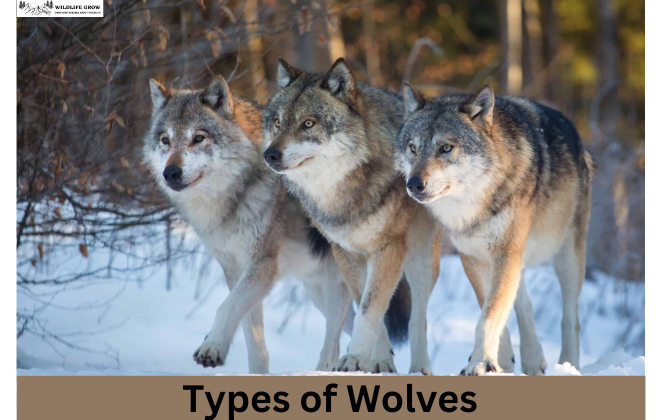Wolves, the majestic and enigmatic creatures of the wild, have long captured the imagination of humans with their haunting howls and mysterious nature. From the snow-cloaked forests of Canada to the arid deserts of Mexico, these apex predators have adapted to a diverse range of habitats, leading to the emergence of various distinct species and subspecies.
In this article, we will embark on a journey through the untamed realms that harbour different types of wolves, exploring their unique characteristics, behaviors, and ecological significance. As we delve into the intricate tapestry of wolf diversity, we will unravel the spellbinding tales of these elusive creatures and gain a deeper understanding of their vital role in maintaining ecological balance.
Different types of wolves
There are different wolf types living in various parts of the world.
Grey Wolf
Grey wolves, also known as timber wolves, are the world’s most iconic and widely recognized species of wolves. They are typically found in North America, Europe, and Asia and have various subspecies that differ in size, colouration, and behaviour.
Another notable subspecies is the Mexican grey Wolf. Once near extinction due to hunting and habitat loss, these wolves were successfully reintroduced into their native range in Arizona and New Mexico. They are smaller than other subspecies but are highly adaptable hunters with a keen sense of smell that allows them to track prey over long distances.
Several subspecies of grey wolves have different physical characteristics, such as size and coat colour. The most common subspecies is the Western Gray Wolf which can weigh up to 80 kg and reach a length of 6 feet. The Eastern Gray Wolf is smaller, with a weight range between 23 and 45 kg.
Grey wolves play an essential role in maintaining balance in their ecosystem by preying on herbivores like elk and deer. They have been hunted for centuries due to fear or misconception, resulting in the endangerment of their species.
Grey wolves have various behaviours and social structures that vary depending on their habitat and location. They typically hunt in packs but can also be solitary hunters when food sources are scarce. Despite being labelled an apex predator in many areas, grey wolves are still threatened by human activities such as hunting and habitat loss. Conservation efforts have been put into place to protect these majestic creatures for future generations.

Red Wolf
Red wolves are a species of wolf native to the southeastern United States. They are the rarest and most endangered wolf species worldwide, with only 40 left in the wild. Red wolves have a distinctive reddish-brown coat, which is where they get their name from. Several wolf types are found worldwide, including grey, arctic, and Ethiopian wolves. All wolf species share specific characteristics, such as pack dynamics and predatory behaviour, each type has unique physical traits and behaviours that make it distinct from other wolves.
One unique trait of red wolves is their ability to hybridize with coyotes. This has led to controversy among conservationists debating whether hybrids should be protected under the endangered species.

Mongolian Wolf
The Mongolian Wolf, known by its scientific name Canis lupus chanco, is a subspecies of the Grey Wolf. It is native to the grasslands and mountainous regions of Mongolia and parts of China. The Mongolian Wolf is a medium-sized wolf with thick fur that varies from grey-brown to yellowish-grey in color. They have a distinctive white patch on their chest which can be used for identification.
The average height of a male Mongolian Wolf ranges from 1 foot, 11 inches to 2 feet, 11 inches, while females are slightly smaller in size. Their weight varies between 22 kg to 30 kg depending on gender and age. Their body length, including their tail, measures around 3 feet, 6 inches, making them relatively shorter than other wolf species, such as the Arctic or Timberwolves.
Mongolian wolves are elusive creatures that prefer to remain hidden from humans. They are skilled hunters, preying on various animals such as deer, elk, wild boar, and smaller mammals like rodents. These wolves also play an essential role in maintaining the ecological balance of their habitat by controlling the population of herbivores. Unfortunately, people of Mongolian wolves have been declining due to habitat loss and human activity such as hunting and trapping.

Himalayan wolf
The Himalayan Wolf is a majestic and elusive creature that roams the mountainous regions of Asia. It is a type of wolf species found in this region. Despite being a lesser-known species, it has gained recognition for its unique features and cultural significance.
The Himalayan Wolf belongs to the Canis lupus family, which includes various subspecies like the Gray Wolf, Red Wolf, and Arctic Wolf. They have distinct physical characteristics that set them apart from other subspecies. Their fur coat is thicker than other wolves, as they need extra insulation to survive in harsh mountain environments. They also have shorter legs than most wolves, making them more agile climbers and allowing them to traverse rocky terrains quickly. This Wolf’s habitat ranges from Pakistan to Nepal and Bhutan across the high-altitude areas of Central Asia.
Belonging to the subspecies of Gray Wolves, these wolves are commonly found in Nepal, Tibet, Bhutan, and India. Standing at a height of 2 feet and 6 inches and weighing around 35 kg, they have adapted themselves to withstand the harsh climate conditions prevailing in these areas.
Despite their robust physique, Himalayan Wolves face a significant threat to their existence due to habitat loss, hunting activities by humans, and interbreeding with domestic dogs. The International Union for Conservation of Nature (IUCN) has classified them as endangered due to their declining population numbers. It is estimated that only around 350 individuals remain in the wild today.
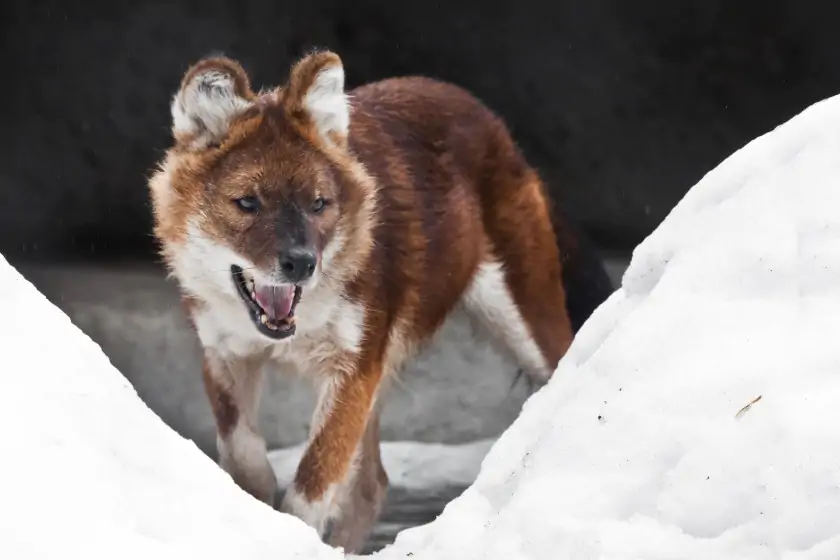
Steppe wolf (Caspian sea wolf)
The Steppe Wolf is a fascinating and mysterious creature inhabiting Eurasia’s vast grasslands. It is one of several wolf types found in this region, each with unique characteristics and behaviors. All wolves share certain traits, such as their pack mentality and hunting prowess, the Steppe Wolf stands out for its ability to thrive in some of the harshest environments on Earth.
This Wolf roams across grassy landscapes, preying on small mammals such as rodents and hares. At 2 feet 4 inches tall and weighing 35-40 kg, the Steppe Wolf is smaller than some of its other wolf counterparts. It makes up for its size with agility and speed. Its powerful legs allow it to run at incredible speeds of up to 60 km/h when chasing prey or escaping danger.
Despite being smaller than other wolves, the Steppe Wolf has adapted well to life on the open plains. Its thick fur coat helps protect it from harsh weather conditions that are common in this region.

Tundra Wolf
The Tundra Wolf, or the Canis lupus albus, is a fascinating creature roaming the Arctic’s vast and desolate lands. These wolves are known for their size, strength, and adaptability to harsh environments. They are a subspecies of grey wolves in different parts of North America and Eurasia.
The striking feature of Tundra Wolves is their height. They can grow up to 3 feet, 2 inches tall at shoulder level, making them taller than most other wolves. Their length ranges from 3 feet, 10 inches to 4 feet, 6 inches long from head to tail. As for their weight, they can weigh anywhere between 36.6 kg to 49 kg depending on factors such as sex and age.

Arctic Wolf
The Arctic Wolf, or Canis lupus arctos, is a subspecies of the Grey Wolf found in the Arctic Circle. It is known for its thick white fur coat that allows it to blend in with the snow and ice. This subspecies of wolves has adapted well to life in the harshest environments on Earth.
Arctic Wolves are typically smaller than other wolf types, weighing between 34 and 46 kg and growing up to three feet tall. They have shorter ears and snouts than their southern counterparts, which helps them retain heat in colder temperatures. Their diet primarily consists of muskoxen, caribou, and Arctic Hares. These wolves are also known for their strong social bonds as they live in packs ranging from two to twenty individuals.
Arctic wolves have a thick coat of fur that allows them to thrive in harsh winter conditions. Their skin is mostly white but can also contain shades of grey and brown. This camouflage helps them blend into their surroundings and stay hidden from prey. When hunting, these wolves target large mammals such as muskoxen, caribou, and arctic hares. They are skilled hunters and will work together to take down larger prey when necessary. To support their large size and active lifestyle, arctic wolves require significant amounts of food each day.
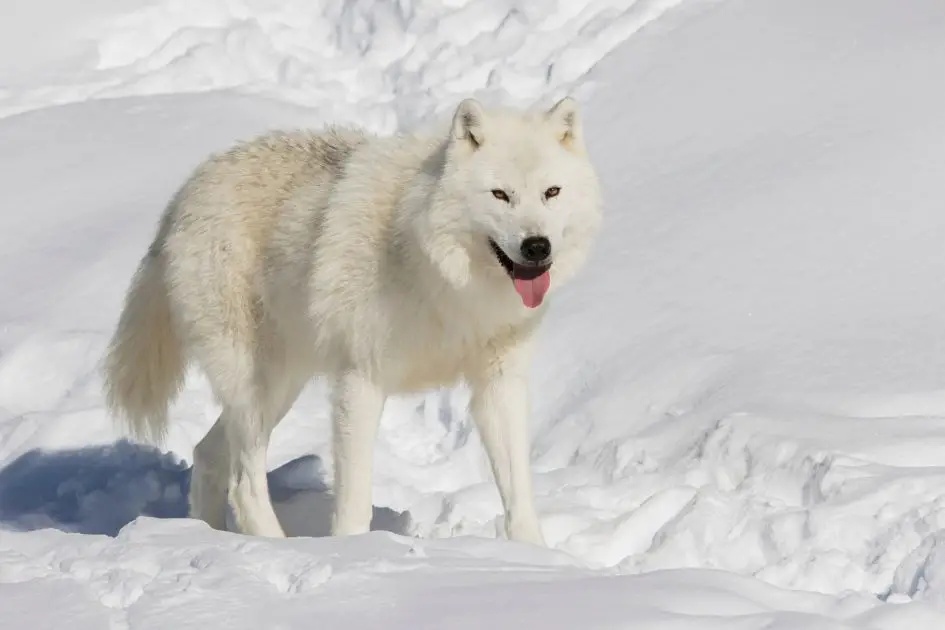
Northern Rocky Mountain Wolf
The Northern Rocky Mountain Wolf, also known as the Gray Wolf or Timber Wolf, is a subspecies of the grey Wolf found throughout North America. It is a significant type of Wolf worldwide known for its distinctive howl that echoes through the mountains.
Standing at a height of 2 feet, 2 inches to 2 feet, 8 inches, and weighing 32 to 68 kilograms, these majestic creatures are a sight to behold. Their thick fur coats protect against harsh winter weather and serve as camouflage in their natural habitat. The Northern Rocky Mountain Wolves live in packs with alpha males and females leading them. They are brilliant animals known to hunt large prey such as elk, deer, and moose.

Eurasian Wolf
The Eurasian Wolf, or the familiar Wolf or grey Wolf, is a subspecies of the Canis lupus species. They are found in various parts of Europe and Asia and have distinctive physical characteristics that set them apart from other wolf types. One noticeable feature is their size, with males weighing between 69 to 80 kilograms and measuring up to 2 feet, 9 inches in height.
Apart from their size, the Eurasian Wolf has a thick fur coat that usually comes in shades of grey or brown. They have a long snout and pointed ears that help them hear even the slightest sounds from afar. Although they are known for their ferocity when hunting prey or protecting their territory, these animals typically live in packs and exhibit social behavior among themselves.
Despite being a common type of Wolf worldwide, the Eurasian Wolf remains a fascinating creature that has captured the imagination of people for centuries. Its distinctive howl echoes through forests and open plains as this majestic animal roams free in its natural habitat. The Eurasian Wolf is also a popular subject for wildlife enthusiasts and photographers who seek to capture its beauty on camera.

Interior Alaskan Wolf (Yukon Wolf)
The Interior Alaskan Wolf, also known as the Yukon Wolf, is the largest subspecies of the Grey Wolf. They have thick fur coats ranging from grey to black and weigh between 32 and 60 kg. These wolves are known for their excellent hunting skills and are often found in packs of six or more.
One unique characteristic of this Wolf is its ability to adapt to extreme weather conditions, making it well-suited for life in Alaska’s harsh climate. The Yukon Wolf has a broad snout, strong jaws, and sharp teeth that help them catch and kill prey. They feed on caribou, moose, muskoxen, and other small mammals like rabbits. Despite being a top predator in their habitat, these wolves have faced threats due to human encroachment on their territory.
These wolves, also known as arctic or tundra wolves, have a wide range of diets depending on which part of Alaska they inhabit. Wolves living in forested areas tend to prey on moose and caribou, those residing in open tundra feed on smaller mammals like lemmings, voles, and hares.
In addition to these typical prey, some Interior Alaskan wolf packs have been observed hunting Dall sheep and mountain goats in high-altitude areas. This shows just how versatile these predators can be when finding food sources. Wolves living near rivers also take advantage of salmon runs during the spawning season as an additional food source.

Northwestern Wolf
The Northwestern Wolf, also known as Canis lupus occidentalis, is a subspecies of the grey wolf species. They are one of North America’s most significant wolf types, standing at an average height of 2 feet and 2 inches to 3 feet and weighing between 45 and 72 kg. These majestic creatures can measure from 5 to 7 feet long from nose to tail.
The Northwestern Wolf is mainly found in the western part of North America, from Alaska down through Montana and into parts of Washington State. They prefer living in forested and mountainous regions where they can freely hunt their prey. Conservationists have classified this subspecies as being among the least concerning regarding their population status compared to other wolf types in North America.
The northwestern Wolf has earned its name due to its geographical range, including Alaska and the United States northwest region. These wolves are stealthy hunters and have adapted well to their environment. The northwestern Wolf’s fur is typically a mix of grey and brown with black accents on the back.
The northwestern Wolf plays an essential role in maintaining balance within its ecosystem. They help control populations of ungulates such as elk, deer, and moose by preying on weak or injured individuals. This keeps herds healthy and reduces overgrazing in areas where these animals live. Despite their importance in nature’s delicate balance, this species has faced many threats throughout history.
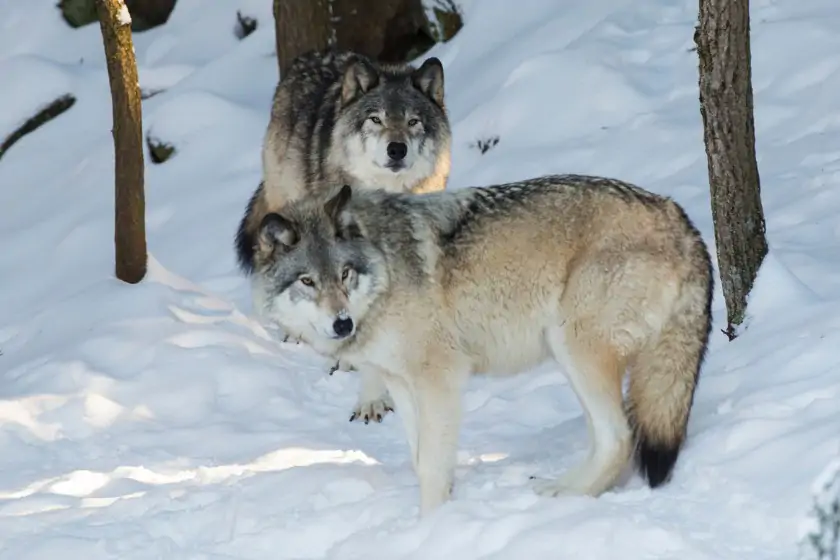
Arabian Wolf
The Arabian Wolf, scientifically known as Canis lupus Arabs, is a grey wolf subspecies native to the Arabian Peninsula. The tall wolf species has a unique appearance with its short, wiry coat, usually reddish-brown or color. The Arabian Wolf stands at an average height of 2 feet and weighs around 20 kilograms, making it the smaller wolf.
The conservation status of this magnificent creature is critically endangered due to human activities such as habitat loss, hunting, and persecution. Their shrinking population size has become a significant concern among animal conservationists worldwide. Despite efforts to conserve this species, such as establishing protected areas for them to thrive in their natural habitat and educating local communities on their importance to the ecosystem, much more must be done if they survive long-term in today’s rapidly changing world.
The Arabian Wolf, also known as the desert wolf, is a small-sized member of the canine family. Unlike their tundra and arctic counterparts, this species stands around two feet tall and weighs about twenty kilograms. The Arabian Wolf is a highly specialized predator that inhabits the Middle East and semi-arid regions of the Middle East.
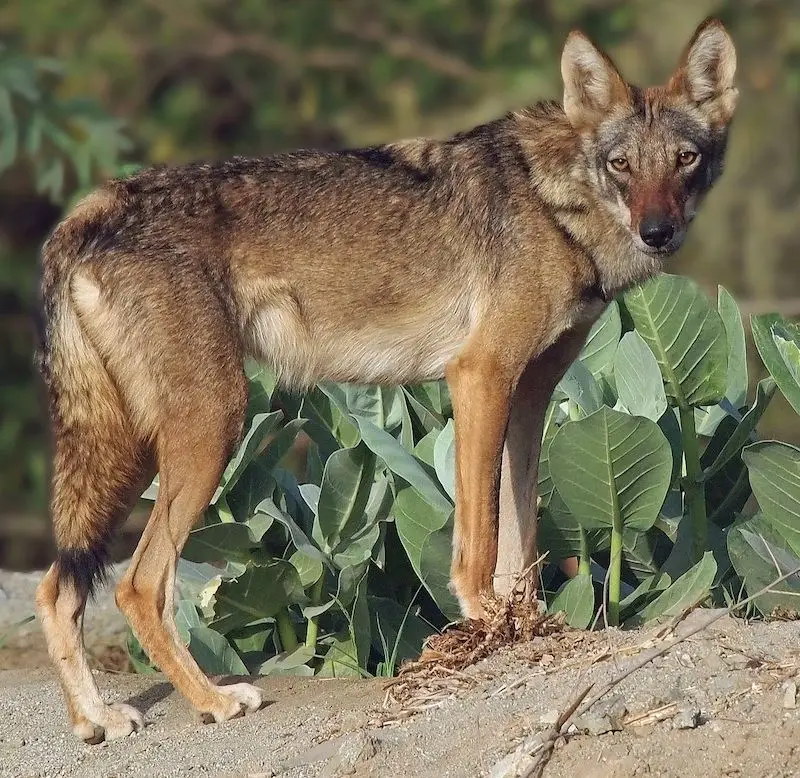
This unique species of Wolf has adapted to survive in an environment where water and prey are scarce. They have developed long legs that allow them to cover large distances quickly, helping them hunt for prey such as rodents, hares, birds, and reptiles. The Arabian Wolf can also tolerate high temperatures due to its ability to conserve water by sweating less than other canids. Despite their incredible adaptations, the Arabian Wolf faces many threats today.
Indian Wolf
The Indian Wolf, also known as the Himalayan wolf or Indian grey Wolf, is a subspecies of the grey Wolf found in India. They have a distinctive reddish-brown coat with short hair and a bushy tail. The scientific name for this subspecies is Canis lupus pallipes.
Indian wolves are typically smaller than their North American cousins, with males weighing between 17 to 25 kg and measuring Between 1 foot, 10 inches to 2 feet, and 4 inches tall at the shoulder. Females are usually slightly smaller. They have longer legs than other wolves, allowing them to move through rough terrain more easily.
Despite being the least world-studied species of wolf, they play an essential role in their ecosystem by controlling prey populations and maintaining biodiversity. This species of Wolf is known for its intelligence and ability to adapt to changing environments. They are social animals that live in packs with a dominant alpha pair leading a group of subordinates. The Indian Wolf primarily feeds on small prey like rodents, birds, and rabbits but will also hunt larger animals like deer if necessary. Unfortunately, habitat loss due to deforestation decreased in population size over recent years, making them an endangered species.

Mexican Wolf
The Mexican Wolf, also known as Canis lupus bailey, is a subspecies of the grey Wolf. It is a minor type of Wolf and can be identified by its distinctive light grey fur with black markings on its back and tail. These wolves have long legs and big paws that enable them to run fast over rough terrain.
The Mexican Wolf’s habitat is mainly in Mexico and parts of the southwestern United States, such as Arizona and New Mexico. They have been listed as endangered since 1976 due to hunting, trapping, and habitat loss. The population has slowly recovered thanks to conservation efforts focused on reintroducing these animals into their natural habitats. Despite being small compared to other wolves, they are still top predators in their environment.
The Mexican Wolf is smaller than other subspecies of grey wolves, measuring between 2 feet 4 inches to 2 feet 8 inches at the shoulder. They are around 22 to 36 kilograms and about five feet six in launches. Their fur ranges from greyish-brown to reddish-brown on their back, with a lighter underbelly.
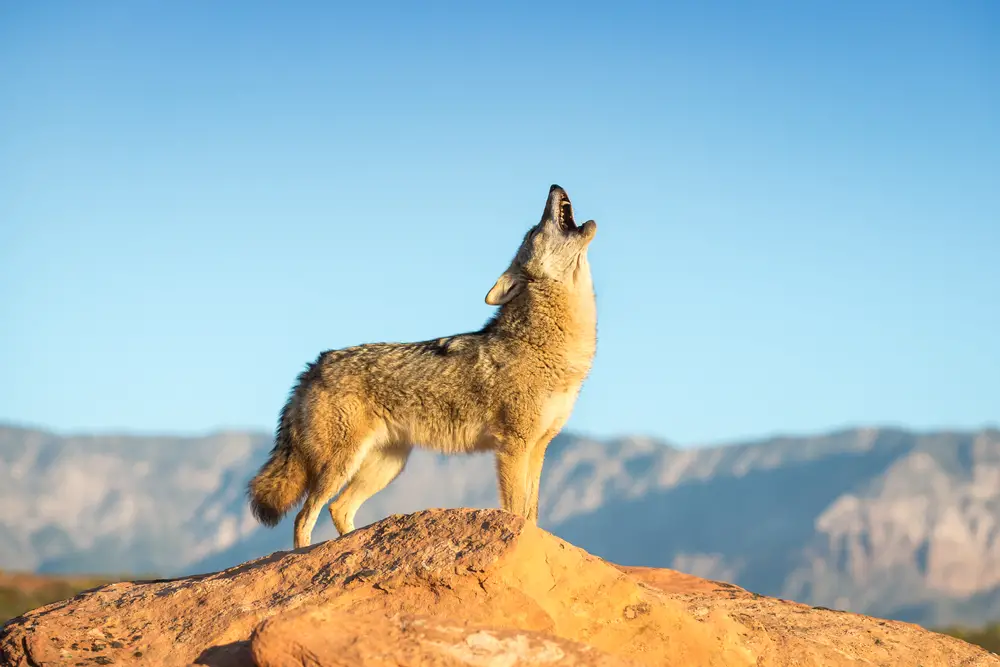
British Colombian Wolf
British Columbian Wolf, also known as the coastal Wolf or sea wolf, is a subspecies of the grey Wolf. They are found in British Columbia and southeastern Alaska, where they inhabit the islands and coastal areas. They are known for their unique habitat preference and behaviour compared to other wolves.
British Columbian Wolves are smaller than their mainland counterparts but have more giant skulls and shorter fur. Their weight ranges from 36 to 68 kg, while their length varies from 5 feet to 5 feet and 10 inches. The coat colour of these wolves also differs from other subspecies; they have darker shades of black, grey, or brownish-grey that help them blend in with their surroundings.
The conservation status of the British Columbian Wolf is currently listed as “apparently,” which means there is not enough data available about this particular subspecies’ population trend.
Vancouver Coastal Island Wolf
The Vancouver coastal island wolf, also known as the sea wolf or marine Wolf, is a distinctive type of Wolf adapted to life on the Pacific coast. Unlike other wolves, this species is an excellent swimmer and has been spotted swimming up to eight miles from Bella Bella, British Columbia. This remarkable aquatic ability allows them to hunt for food along the shoreline and even venture out to nearby islands in search of prey.
The Vancouver coastal island wolf is a subspecies of grey Wolf that only inhabits the central coast region of British Columbia. They are smaller than their mainland counterparts and have shorter fur better suited to wet environments. Their special diet includes salmon, shellfish, and other sea creatures they catch by diving into the water or scavenging along the beach. These wolves also have a solid social structure and live in packs ranging from two to twelve individuals.
The Vancouver Coastal Island Wolf is known for its smaller size compared to other subspecies of Wolf. On average, they stand at 2 feet and 2 inches to 2 feet and 8 inches tall, weigh around 27 kg, and have a length of about 4 feet. Their fur is typically dark grey or black with white markings on their chest and throat.
Despite their small stature, these wolves are skilled hunters essential in maintaining ecological balance on the island. They primarily feed on deer but also prey on smaller animals like rodents. Sadly, the population of Vancouver Coastal Island Wolves has been declining due to habitat loss and human activity such as hunting.
Hudson Bay Wolf
The Hudson Bay Wolf is a subspecies of the grey Wolf, commonly found in Canada and Alaska.
With their fierce reputation as hunters, these wolves also play an essential role in maintaining the ecosystem by controlling populations of other animals. The Hudson Bay Wolf, also known as Canis lupus hudsonicus, is a subspecies of the Gray Wolf found in North America. These wolves have adapted to living in colder climates and have unique physical characteristics that distinguish them from other wolf species. Standing at 2 feet and 4 inches to 2 feet and 11 inches tall, with a weight ranging from 38 to 70 kilograms and a length of up to 3 feet and 11 inches, the Hudson Bay Wolf is an iconic part of Canada’s wilderness.
One notable characteristic of this wolf subspecies is its fur colouration. Generally speaking, Hudson Bay Wolves tend to have lighter-colored fur than other Gray Wolf subspecies. Their coats range in color from almost white to light grey or brownish-grey.
Alexander Archipelago Wolf
The Alexander Archipelago Wolf is a unique subspecies of the Gray Wolf found in the temperate rainforests of Southeast Alaska. The scientific name for this Wolf is Canis lupus legion, and it’s known for its smaller size compared to other wolf types. Standing only 2 feet tall and weighing 14 to 23 kg, they are often described as more agile than their larger counterparts.
Despite their small stature, Alexander Archipelago Wolves are skilled hunters with sharp teeth and powerful jaws. They primarily feed on Sitka black-tailed deer but also prey on smaller mammals like rabbits and hares. Due to habitat destruction, hunting pressure, and the decline in prey availability, this subspecies has been listed as “vulnerable” by the International Union for Conservation of Nature (IUCN).
Eastern Wolf
The Eastern Wolf, also known by its scientific name Canis lupus lycaon, is the many subspecies of wolves that roam across North America. This type of Wolf can be found in eastern Canada and parts of the northeastern United States. Compared to other wolf types, the Eastern Wolf is relatively more minor, with a height ranging from 2 feet, 1 inch to 3 inches, and weighing between 24 to 30 kg.
Despite their small stature, these wolves are intelligent and adaptable creatures. They have a keen sense of smell and hearing, which helps them locate prey such as deer, and moose and small mammals like rabbits.
Mackenzie River Wolf
The Mackenzie River Wolf, scientifically known as Canis lupus Mackenzie, is a subspecific or timber wolf. It can subspecies be found in the boreal forests and tundra regions of North America, particularly in Alaska and western Canada. This type of Wolf is more significant than its counterparts from other regions and has a thicker coat to withstand harsher climates. Around 7,000 Mackenzie River Wolves are estimated to remain in the wild.
Despite its size and strength, the Mackenzie River Wolf faces threats to its survival due to habitat loss, hunting pressures, and climate change. The International Union for Conservation of Nature (IUCN) has listed this subspecies as “Least Concern” on their Red List since it still has a relatively stable population.
Baffin Island Wolf
The Baffin Island Wolf, scientifically known as Canis lupus manning, is a subspecies of the Gray Wolf. It is only found on Baffin Island, located in the Canadian Arctic Archipelago. These wolves have adapted to living in an extremely harsh environment where temperatures can drop to -50°C during winter. As a result, they have developed smaller ears and shorter muzzles than other subspecies of wolves.
These wolves are medium-sized and typically range from 2 to 3 feet, 6 inches tall. They weigh between 13.6 kg to 22.7 kg and are about 3 feet, 6 inches long from head to tail. Their fur varies from light greyish-brown to black, with some having white patches around their necks or bellies.
Greenland Wolf
The scientific name of the Greenland Wolf is Canis lupus Orion, a sub-species of the grey Wolf. These wolves are found in Greenland, where they inhabit the harsh arctic tundra regions. They are known for their distinct white fur that helps them blend into their snowy surroundings.
The average weight of a mature Greenland Wolf is around 26 kg, making them smaller than other wolf types, such as the Grey Wolf. Despite their smaller size, they are still formidable hunters and can take down large prey such as caribou and musk oxen.
Greenland Wolves are also known for their impressive length, measuring up to 5 feet and 1 inch from nose to tail. This gives them an advantage when hunting in deep snow or traversing vast expanses of ice.
Alaskan Tundra Wolf
The Alaskan Tundra Wolf, also known as Canis lupus tundrarum, is a gray Wolf subspecies inhabiting Alaska’s arctic and alpine regions. As one of North America’s most significant types of words, it can stand up to 3 feet and 2 inches tall at the shoulder and weigh up to 80 kg. Its distinctive features include a thick white coat that helps it blend into its snowy surroundings, long legs adapted for running across open tundra, and powerful jaws capable of taking down large prey such as caribou.
Despite being feared predators in the region, Alaskan Tundra Wolves are highly social animals that live in packs ranging from two to twenty individuals. Each box has a strict hierarchy, with alpha males and females leading the group.
Iberian Wolf
The Iberian wolf, scientifically known as Canis lupus signatus, is a subspecies of the gray Wolf and is found primarily in the Iberian Peninsula. Measuring 2 feet, 3 inches to 2 feet, 7 inches at the shoulder, and weighing between 25 to 55 kg, it is the smaller subspecies of wolves. Despite its smaller size, this species has a formidable reputation for being a fierce predator.
One distinctive feature of the Iberian Wolf is its brownish-grey fur with black-tipped hairs. This colouring provides excellent camouflage in their natural habitat among rocky terrain and forests. Their diet consists mainly of wild boar, deer, and small mammals such as rabbits and hares. Unlike other subspecies, they are not known for attacking livestock or humans unless provoked or threatened.
Italian Wolf
The Italian Wolf, scientifically known as Canis lupus italics, is a subspecies of the grey Wolf. These wolves are smaller than other subspecies and have distinctive reddish-brown fur coats. They are predominantly found in Italy, where they are considered an essential part of the country’s cultural heritage.
Italian wolves typically stand at a height of 1 foot 8 inches to 2 feet 4 inches and weigh between 25 to 45 kg. Their length ranges from 3 feet 6 inches to 4 feet 9 inches. These wolves have adapted to living in mountainous regions and dense forests where they hunt their prey – mostly deer, wild boar, and small rodents.
Despite being protected under national laws since the early twentieth century, Italian wolves remain threatened by human activities such as habitat loss and poaching.
The Italian Wolf, also known as the Apennine wolf, is a subspecies of the gray Wolf that has been controversial for years. This elusive and majestic creature inhabits the rugged terrain of the Apennine Mountains and the Western Alps, where it has adapted to survive in some of Europe’s harshest environments.
Despite its essential role in maintaining ecological balance and biodiversity in these regions, the Italian Wolf remains one of Europe’s most endangered species. The pressures of human development and hunting have led to significant declines in its population over time, with conservationists working tirelessly to protect this magnificent animal from extinction. Despite these efforts, debate continues about whether or not the Italian Wolf should be considered a distinct subspecies or simply a regional variant of the more prominent gray wolf family.
Labrador Wolf
The Labrador Wolf, scientifically known as Canis lupus labradorius, is a subspecies of the gray Wolf native to Canada. These wolves are generally smaller than other wolves and weigh between 27 to 32 kilograms. Their average length ranges from 4 feet, 4 inches to 6 feet, 2 inches.
Despite their small size, these wolves are brilliant and social animals. They live in packs consisting of an alpha male and female, along with their offspring. The group typically hunts together and communicates through body language, vocalizations, and scent marking.
Unfortunately, the Labrador Wolf faces various threats that have led to its vulnerable conservation status. Habitat loss due to human activities such as logging and mining has impacted their natural range They face persecution from humans who view them as a threat to livestock or game animals.
Great Plan Wolf
The Great Plains Wolf, also known as Canis lupus nubilus, is a subspecies of the Grey Wolf. These wolves are native to the Great Plains region of North America and are considered significant wolf types. They weigh around 45 kilograms and can measure up to 6 feet, 5 inches in length from nose to tail.
Despite their large size, Great Plains Wolves are highly elusive creatures. Their extensive range spans grasslands, prairies, and even forests. Their diet consists mainly of large ungulates such as elk and bison, but they also feed on smaller mammals like rabbits and rodents. Due to habitat loss and hunting by humans in the past few decades, their population has declined drastically, leading to them being classified as endangered. Great Plains Wolves possess incredible agility and strength, which makes them formidable hunters.
Extant Wolf Species
The world has lost many extinct wolf species; the wolf family is no exception. Amongst the extinct wolf species are the
1) Dire Wolf (Aenocyon virus)
2) Japanese Wolf (Canis lupus Hodophilax)
3) Cave Wolf (Canis lupus Spelaeus)
4) Newfoundland wolf (Canis lupus Monstrabilis).
Each of these wolves had unique characteristics that set them apart from modern-day wolves.
The Dire Wolf, for instance, was a prehistoric predator that roamed North America during the Pleistocene Epoch. This magnificent creature weighed up to 150 pounds and had a much broader skull than today’s gray Wolf. The Japanese Wolf was once found throughout Japan but went extinct in the early 20th century due to habitat destruction and hunting.
Conclusion
The world of wolves is a diverse and fascinating one, with a variety of species inhabiting different regions and ecosystems. From the iconic grey wolf to the elusive red wolf, each type of wolf plays a unique role in its environment. Understanding and appreciating these different species is crucial for conservation efforts and the preservation of biodiversity. By learning about the various types of wolves, we can better appreciate their significance and advocate for their protection. Let’s continue to educate ourselves about these magnificent creatures and work towards ensuring their survival for future generations to come.
Frequently Asked Questions
What is the Alaskan Tundra Wolf?
The Alaskan Tundra Wolf is a subspecies of the grey Wolf that ranges from the north-central region of Alaska to the east coast of Siberia.
What is the biggest Wolf in the world?
The most enormous Wolf in the world is the grey Wolf, found in North America.
What are the different types of wolves?
There are several types of wolves, including gray wolves, red wolves, Ethiopian wolves, and Arctic wolves.
- Where do Foxes Live? | 11 Big Places Foxes Call Home - December 13, 2023
- Lion Predators: What Hunts Lions? | 5 Lion Enemies - December 11, 2023
- Fox Hunting | The Complete History - November 28, 2023

